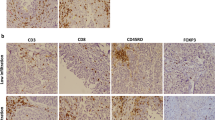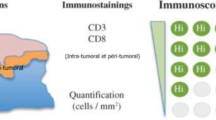Abstract
Background
Intratumoural lymphocytic infiltration is strongly associated with the outcome of many human epithelial cancers. The current paper investigated whether subpopulations of tumour-infiltrating T lymphocytes are associated with certain clinicopathological parameters and the prognosis of patients with invasive bladder cancer (BCa).
Patients and methods
The infiltration densities of the adaptive immune markers CD3 (the whole T cell population), FOXP3 (regulatory T cells; Tregs), CD8 (T effector cells) and CD45R0 (T effector memory cells) were analysed by immunohistochemistry and image analysis with tissue microarrays of tumour tissues from 149 patients with invasive BCa treated with radical cystectomy. The findings were correlated with certain clinicopathological parameters.
Results
Higher FOXP3/CD3 [OS: p = 0.016, HR 1.29, 95 % confidence intervals (95 % CIs 1.05–1.59)] and FOXP3/CD8 (OS: p = 0.013, HR 1.32, 95 % CIs 1.06–1.65) ratios were significantly associated with briefer overall survival and time to cancer-specific death; the latter ratio represented an independent prognostic factor according to a multivariate analysis adjusted for pathological T and N stages (HR 1.32, 95 % CIs 1.05–1.67, p = 0.018). The infiltration densities of individual markers (CD3, CD8, FOXP3 and CD45R0) were not significantly associated with clinicopathological parameters or survival; however, a trend towards a better outcome was observed for higher log-transformed CD8 (p = 0.070, HR 0.80, 95 % CIs 0.63–1.02) and CD3 (p = 0.113, HR 0.84, 95 % CIs 0.68–1.04) infiltration values.
Conclusions
A high fraction of Tregs amongst CD3- and CD8-positive lymphocytes indicated a poor prognosis, thereby emphasising the important role that Tregs play in the suppression of the anti-tumour immune response. No single lymphocytic marker was significantly correlated with clinical outcomes, but high CD3 and CD8 infiltration showed trends towards better prognosis.




Similar content being viewed by others
References
Schreiber RD, Old LJ, Smyth MJ (2011) Cancer immunoediting: integrating immunity’s roles in cancer suppression and promotion. Science 331:1565–1570
Galon J, Costes A, Sanchez-Cabo F et al (2006) Type, density, and location of immune cells within human colorectal tumors predict clinical outcome. Science 313:1960–1964
Mlecnik B, Tosolini M, Kirilovsky A et al (2011) Histopathologic-based prognostic factors of colorectal cancers are associated with the state of the local immune reaction. J Clin Oncol 29:610–618
Sharma P, Shen Y, Wen S et al (2007) CD8 tumor-infiltrating lymphocytes are predictive of survival in muscle-invasive urothelial carcinoma. Proc Natl Acad Sci USA 104:3967–3972
Sato E, Olson SH, Ahn J et al (2005) Intraepithelial CD8+ tumor-infiltrating lymphocytes and a high CD8+/regulatory T cell ratio are associated with favorable prognosis in ovarian cancer. Proc Natl Acad Sci USA 102:18538–18543
Zhang L, Conejo-Garcia JR, Katsaros D et al (2003) Intratumoral T cells, recurrence, and survival in epithelial ovarian cancer. N Engl J Med 348:203–213
Gao Q, Qiu SJ, Fan J et al (2007) Intratumoral balance of regulatory and cytotoxic T cells is associated with prognosis of hepatocellular carcinoma after resection. J Clin Oncol 25:2586–2593
Salama P, Phillips M, Grieu F et al (2009) Tumor-infiltrating FOXP3+ T regulatory cells show strong prognostic significance in colorectal cancer. J Clin Oncol 27:186–192
Curiel TJ, Coukos G, Zou L et al (2004) Specific recruitment of regulatory T cells in ovarian carcinoma fosters immune privilege and predicts reduced survival. Nat Med 10:942–949
Hiraoka N, Onozato K, Kosuge T, Hirohashi S (2006) Prevalence of FOXP3+ regulatory T cells increases during the progression of pancreatic ductal adenocarcinoma and its premalignant lesions. Clin Cancer Res 12:5423–5434
Winerdal ME, Marits P, Winerdal M et al (2011) FOXP3 and survival in urinary bladder cancer. BJU Int 108(10):1672–1678
Therneau T, Grambsch P (2000) Modeling survival data: extending the Cox model. Springer, New York
Hothorn T, Zeileis A (2008) Generalized maximally selected statistics Bias in random forest variable importance measures: illustrations, sources and a solution. Biometrics 64(4):1263–1269
Schemper M, Smith TL (1996) A note on quantifying follow-up in studies of failure time. Control Clin Trials 17(4):343–346
Horn T, Grab J, Schusdziarra J et al (2013) Antitumor T cell responses in bladder cancer are directed against a limited set of antigens and are modulated by regulatory T cells and routine treatment approaches. Int J Cancer 133:2145–2156
Otto W, Denzinger S, Wieland WF, Hartmann A (2012) First analysis of immune cell infiltration in stage pT1 urothelial bladder carcinoma: CD3 positivity as a prognostic marker for cancer-specific survival. World J Urol 30:875–877
Kobayashi N, Hiraoka N, Yamagami W, Ojima H, Kanai Y, Kosuge T, Nakajima A, Hirohashi S (2007) FOXP3+ regulatory T cells affect the development and progression of hepatocarcinogenesis. Clin Cancer Res 13(3):902–911
Choi W, Porten S, Kim S et al (2014) Identification of distinct basal and luminal subtypes of muscle-invasive bladder cancer with different sensitivities to frontline chemotherapy. Cancer Cell 25(2):156–165
Powles T, Eder JP, Fine GD et al (2014) MPDL3280A (anti-PD-L1) treatment leads to clinical activity in metastatic bladder cancer. Nature 515:558–562
Xylinas E, Robinson BD, Kluth LA et al (2014) Association of T-cell co-regulatory protein expression with clinical outcomes following radical cystectomy for urothelial carcinoma of the bladder. Eur J Surg Oncol 40:121–127
Bellmunt J, Mullane SA, Werner L, Fay AP, Callea M, Leow JJ, Taplin ME, Choueiri TK, Hodi FS, Freeman GJ, Signoretti S (2015) Association of PD-L1 expression on tumor-infiltrating mononuclear cells and overall survival in patients with urothelial carcinoma. Ann Oncol 26(4):812–817. doi:10.1093/annonc/mdv009
Acknowledgments
This work was funded by the Else-Kröner-Fresenius-Stiftung.
Conflict of interest
The authors declare that there is no conflict of interest.
Ethical standard
Before its initiation, the study was approved by the local ethics committee (5191/2011).
Author information
Authors and Affiliations
Corresponding author
Rights and permissions
About this article
Cite this article
Horn, T., Laus, J., Seitz, A.K. et al. The prognostic effect of tumour-infiltrating lymphocytic subpopulations in bladder cancer. World J Urol 34, 181–187 (2016). https://doi.org/10.1007/s00345-015-1615-3
Received:
Accepted:
Published:
Issue Date:
DOI: https://doi.org/10.1007/s00345-015-1615-3




